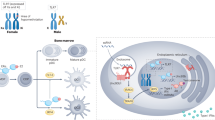Abstract
Histocompatibility-Y (H-Y) antigen, the presumptive inducer of the mammalian testis, is present in the cells of normal males and not in the cells of normal females. Recent reports have implied that patients with transsexualism exhibit H-Y antigen phenotypes at variance with those of normal males and females and, thus, that H-Y serology might provide a tool for the diagnosis and study of the transsexual condition. We therefore evaluated blood and testicular cells from 21 male-to-female transsexuals using conventional and monoclonal H-Y antibodies. We found no evidence of abnormal H-Y phenotype. Five of the patients were interviewed postoperatively by two examiners and rated for the diagnosis of transsexualism. Three of the five were rated primary transsexual by one or both examiners, and two were rated secondary transsexual.
Similar content being viewed by others
References
Benjamin, H. (1966).The Transsexual Phenomenon. Julian Press, New York.
Browning, M. H., Ivanyi, P., and van Mourik, P. (1981). Normal mouse sera react specifically with human lymphoblastoid cell lines.Transplant. Proc. 13: 1962–1965.
de la Balze, F. A., Gurtman, A. I., Jonches, M., Arrillaga, F., Alvarez, A. S., and Segal, L. (1962). Effects of estrogens on the adult human testes, with special reference to the germinal epithelium; a histologic study.J. Clin. Endocrinol. Metab. 22: 1251–1261.
Cicarese, S., Massari, S., and Guanti, G. (1982). Sexual behaviour is independent of H-Y antigen constitution.Human Genet. 60: 371–372.
Cleve, H. (1982). H-Y antigen and sex determination. In Peeters, H. (ed.),Protides of the Biological Fluids Pergamon Press, New York.
Eicher, W., Spoljar, M., Cleve, H., Murken, J. D., Richter, K., and Stengel-Rutkowski, S. (1979). H-Y antigen in trans-sexuality.Lancet 2: 1137–1138.
Eicher, W., Spoljar, M., Richter, K., Cleve, H., Murken, J.-D., Stengel-Rutkowski, S., and Steindl, E. (1980). Transsexualitat and H-Y antigen.Geburtschilfe Frauenheilkd 40: 529–540.
Engel, W., Pfafflin, F., and Wiedenking, C. (1980). H-Y antigen in transsexuality, and how to explain testis differentiation in H-Y antigen-negative males and ovary differentiation in H-Y antigen-positive females.Human Genet. 55: 315–319.
Flaherty, L., Zimmerman, D., and Wachtel, S. S. (1979). H-Y antigen: Cell surface mapping and testosterone-induced supramolecular repatterning.J. Exp. Med. 150: 1020–1027.
Futterweit, W. (1980). Endocrine management of the transsexual. Hormonal profiles of serum prolactin, tetosterone, and estradiol.N. Y. State J. Med. 80: 1260–1264.
Goldberg, E. H., Boyse, E. A., Bennett, D., Scheid, M., and Carswell, E. A. (1971). Serological demonstration of H-Y (male) antigen on mouse sperm.Nature 232: 478–480.
Green, R., and Money, J. (eds.). (1969).Transsexualism and Sex Reassignment. The Johns Hopkins Press, Baltimore.
Kelly, T. E., Wachtel, S. S., Cahill, L., Barnabei, V. M., Willson-Suddath, K., and Wyandt, H. E. (1984). X;Y translocation in a female with streak gonads, H-Y-phenotype, and some features of Turner's syndrome.Cytogenet. Cell Genet. 38: 122–126.
Kohler, G., and Milstein, C. (1975). Continuous cultures of fused cells secreting antibody of predefined specificity.Nature 265: 495–497.
Laub, D., and Green, R. (eds.). (1978). The Fourth International Conference on Gender Identity.Arch. Sex. Behav. 7.
Lu, C. C., and Steinberger, A. (1978). Effects of estrogen on human seminiferous tubules: Light and electron microscopic analysis.Amer. J. Anat. 153: 1–14.
Mickova, M. (1974). The effect of orchiectomy on the manifestation of thymus 1-B theta C-3H antigen in H-2 congenic mouse strains.Folia Biologica (Prague) 20: 343–345.
Ohno, S. (1977). The original function of MHC antigens as the general plasma membrane anchorage site of organogenesis-directing proteins.Immunol. Rev. 33: 59–69.
Ohno, S., and Stapleton, D. W. (1981). Associative recognition of testis-organizing H-Y antigen and immunological confusion. In Jagiello, G., and Vogel, H. J. (eds.),Bioregulators of Reproduction Academic Press, New York.
Ohno, S., Nagai, Y., Ciccarese, S., and Iwata, H. (1979). Testis-organizing H-Y antigen and the primary sex-determining mechanism of mammals.Rec. Prog. Horm. Res. 35: 449–470.
Sohval, A. R., and Gabrilove, J. L. (1965). Testicular histopathology in feminizing tumors of the adrenal cortex.J. Urol. 93: 711–716.
Spoljar, M., Eicher, W., Eiremann, W., and Cleve, H. (1981). H-Y antigen expression in different tissues from transsexuals.Human Genet. 57: 52–57.
Stoller, R. J. (1968).Sex and Gender: On the Development of Masculinity and Femininity. Science House, New York.
Wachtel, S. S. (1983).H-Y Antigen and the Biology of Sex Determination. Grune & Stratton, New York.
Zenzes, M. T., and Reed, T. E. (1984). Variability in serologically detected male antigen titer and some resulting problems: A critical review.Human Genet. 66: 103–109.
Author information
Authors and Affiliations
Additional information
Supported in part by grants from the Dwight School Foundation and NIH AI 19456 to SW; HD 17049 to RG; and HD 17456 and the Lehigh University Research Fund to NGS.
Rights and permissions
About this article
Cite this article
Wachtel, S., Green, R., Simon, N.G. et al. On the expression of H-Y antigen in transsexuals. Arch Sex Behav 15, 51–68 (1986). https://doi.org/10.1007/BF01542304
Issue Date:
DOI: https://doi.org/10.1007/BF01542304




